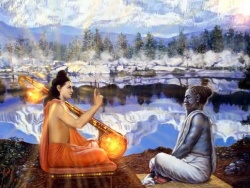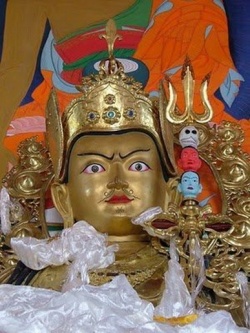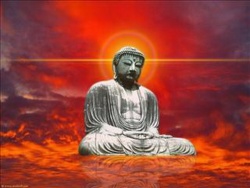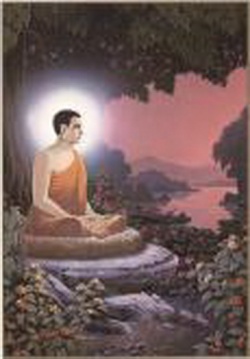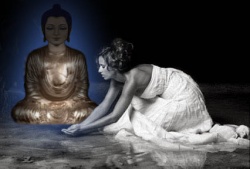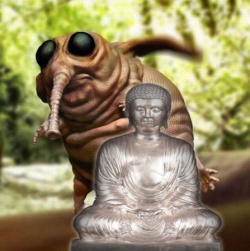Samkhya
Early non-Buddhist philosophical school; the so-called "enumerators," because they advocate a definite enumeration of the causes that produce existents.
Samkhya (Skt. sāṃkhya; Tib. གྲངས་ཅན་པ་, drangchenpa; Wyl. grangs can pa) - The Samkhya, or 'Enumerators', are non-Buddhist eternalists. They are followers of the sage Kapila (Wyl. ser skya). They assert that all objects of knowledge can be classified into twenty-five principles. A non-Buddhist school, the oldest of the Brahmanic schools
The Samkhyas believe that beings circle in samsara due to mistakenly believing the fundamental nature or prakriti (Skt.) and the person or purusha (Skt.) to be one, and not understanding that modulations or transformations (Wyl. rnam ‘gyur) are manifested by the prakriti. By receiving instructions from a guru, a practitioner can understand that the transformations are only manifestations of the prakriti and gradually let go of attachment to phenomena. Through meditation the practitioner develops the divine eye and then, when seeing prakriti with this divine eye, the prakriti ‘blushes’, like a mistress seen by the wife, and disappears with the transformations, leaving the self all alone. This means that all conventional phenomena disappear from the mind of the yogi. That is liberation.
Subdivisions
There are two kinds of Samkhyas: non-theists and theists who believe in Ishvara.
See Also
Source
Samkhya is one of the most prominent and one of the oldest of Indian philosophies. An eminent, great sage Kapila was the founder of the Samkhya School.
Based on the Upanishads, two schools of philosophy developed in India: (1) The realistic (e.g. Samkhya) (2) The idealistic (e.g.Vedanta). The Samkhya philosophy combines the basic doctrines of Samkhya and Yoga. However it should be remembered that the Samkhya represents the theory and Yoga represents the application or the practical aspects.
The word Samkhya is based upon the Sanskrit word samkhya which means ‘number’. The school specifies the number and nature of the ultimate constituents of the universe and thereby imparts knowledge of reality. In fact, the term Samkhya also means perfect knowledge. Hence it is a system of perfect knowledge.
Samkhya is dualistic realism. It is dualistic because it advocates two ultimate realities: Prakriti, matter and Purusha, self (spirit). Samkhya is realism as it considers that both matter and spirit are equally real. Samkhya is pluralistic also because of its teaching that Purusha is not one but many.
Samkhya, to some extent, differs from Nyaya -Vaisheshika and Jainism. While Nyaya-Vaisheshika and Jainism contend that the atoms are the ultimate constituents of the physical world, Samkhya differs on the issue. According to Samkhya the cause is always subtler than the effect.
The Samkhya theory argues: How can so gross atoms of matter can be the cause of such subtle and fine objects as mind and intellect? The Samkhya proposes that some finest and subtlest stuff or principle underlies all physical existence. Samkhya names it as Prakriti. Prakriti is the primordial substance behind the world. It is the material cause of the world. Prakriti is the first and ultimate cause of all gross and subtle objects.
Prakriti is the non-self. It is devoid of consciousness Prakriti is unintelligible and gets greatly influenced by the Purusha, the self. It can only manifest itself as the various objects of experience of the Purusha
Prakriti is constituted of three gunas, namely sattva, rajas and tamas. The term guna, in ordinary sense means quality or nature. But here, it is to be understood in the sense of constituent (component) in Samkhya. Sattva is concerned with happiness. While rajas is concerned with action, tamas is associated with ignorance and inaction.
Sattva is the guna whose essence is purity, fineness and subtlety. Sattva is the component concerned with lightness, brightness and pleasure. Sattva is associated with ego, mind and intelligence. Its association with the consciousness is the strongest. Though sattva is an essential condition for consciousness, it is not sufficient. It should be remembered that consciousness is exclusively the Purusha.
Rajas is concerned with the actions of objects. It is associated with activity and motion. In material objects, motion and action are the results of rajas. In living beings not only activity and restlessness, but pain also are caused by rajas.
Tamas is the constituent concerned with the inertia and inaction. In material objects, it resists motion and activity. In living beings, it is associated with coarseness, negligence, indifference and inactivity. In man, it manifests itself as ignorance, insensitivity and inaction.
There are two views on the theory of causation in the Indian philosophy:
(1) Satkaryavada(pre-existence of the effect in the cause): It maintains that karya (effect) is sat or real. It is present in the karana (cause) in a potential form, even before its manifestation.
(2) Asatkaryavada (non-existence of the effect in the cause): It maintains that karya (effect) is asat or unreal until it comes into being. Every effect, then, is a new beginning and is not born out of cause. Charvakism and Nyaya -Vaisheshika systems favour asatkaryavada.
The Samkhya as well as the Vedanta uphold the satkaryavada but their interpretations are different.
There are two different interpretations of satkaryavada – Prakriti -parinamavada and Brahma-vivartavada.
The Parinamavada suggests that the effect is the real parinama (or transformation) of the cause. On the other hand, the Brahma-vivartavada suggests that the effect is an apparent or distorted appearance of the cause. The Advaita Vedanta supports the Brahma-vivartavada. It defends vivartavada and holds that transformation is only apparent, as the Brahman is the only true cause and the world is a distorted appearance of the cause. The Samkhya favours Prakriti-parinamavada.
In accordance with the satkaryavada, the Samkhya maintains that the three gunas of Prakriti are also associated with all the world-objects. Prakriti is the primordial and ultimate cause of all physical existence. Naturally the three gunas which constitute Prakriti also constitute every object of the physical world. Prakriti is never static. Even before evolution, the gunas are relentlessly changing and balancing each other. As a result, Prakriti and all the physical objects that are effected or produced by Prakriti, are also in a state of constant change and transformation. This is further confirmed by the scientists today. It is now proved beyond doubt that ultra-minute particles of objects – like electrons – are in a state of incessant motion and transformation.
According to Samkhya, the efficient cause of the world is Purusha and the material cause is the Prakriti. Here Purusha stands for the ‘Supreme spirit’ and Prakriti stands for ‘matter’. Purusha (spirit) is the first principle of Samkhya. Prakriti is the second, the material principle of Samkhya.
Purusha is neither produced nor does it produce. Prakriti is not produced but it produces.
Prakriti is uncaused. It is eternal. It itself is not produced but it has inherent potential or tendency to produce.
Purusha(like the Brahman of Vedanta) is the Transcendental Self. It is absolute, independent, free, imperceptible, unknowable, above any experience and beyond any words or explanation. It remains pure, “nonattributive consciousness ”.
Prakriti is the material cause of the world. Prakriti is dynamic. Its dynamism is attributed to its constituent gunas. The gunas are not only constituents, nor are they simply qualities. The gunas are the very essence of Prakriti. Gunas are constituents not only of Prakriti but also of all world-objects as they are produced by Prakriti. Prakriti is considered homogeneous and its constituent gunas cannot be separated. The gunas are always changing, rendering a dynamic character to Prakriti. Still a balance among three gunas is maintained in Prakriti. The changes in the gunas and in the Prakriti may take two forms: Homogeneous and Heterogeneous. Homogeneous changes do not affect the state of equilibrium in the Prakriti. As a result, worldly objects are not produced. Heterogeneous changes involve radical interaction among the three gunas. They disturb the state of equilibrium. This is the preliminary phase of the evolution. The evolutionary process is initiated by the rajas, which activates sattva and then the two gunas overpower the inertia of the tamas. An important factor behind the disturbance is Purusha . The relation between Purusha and Prakriti may be compared to that between a magnet and a piece of iron. Purusha itself does not come into contact with Prakriti. But it influences Prakriti. Thus, the Prakriti is prompted to produce. As the gunas undergo more and more changes, Prakriti goes on differentiating into numerous, various world-objects. Thus it becomes more and more determinate. This is what is termed as evolution.
In evolution, Prakriti is transformed and differentiated into multiplicity of objects. Evolution is followed by dissolution. In dissolution the physical existence, all the worldly objects mingle back into Prakriti, which now remains as the undifferentiated, primordial substance. This is how the cycles of evolution and dissolution follow each other.
According to Samkhya the radical interactions among the three gunas disturb the state of equilibrium in Prakriti. Then there may be dominance of one or the other guna. This disequilibrium, with certain other influencing factors, prompts Prakriti to differentiate into world-objects.
The evolution results in 23 different categories of objects. They comprise of three elements of Antahkaranas or the internal organs as well as the ten Bahyakaranas or the external organs.
Among all these, the first to evolve is Mahat(the great one). Mahat evolves as a result of preponderance of sattva. Since it is an evolute of Prakriti, it is made of matter. But it has psychological, intellectual aspect known as buddhi or intellect. Mahat or intellect is a unique faculty of human beings. It helps man in judgment and discrimination. Mahat helps to distinguish between the subject and the object. Man comes to understand the self and the non-self, the experiencer and the experienced as distinct entities with Mahat. Mahat, by its inherent association with sattva, possesses qualities like luminosity and reflectivity. Buddhi can reflect Purusha owing to these qualities.
The second evolute is ahamkara (ego). It arises out of the cosmic nature of Mahat. Ahamkara is the self-sense. It is concerned with the self-identity and it brings about awareness of “I” and “mine”.
According to the Samkhya there emanates two sets of objects from ahamkara. The first set comprises of the manas (mind), the five sense-organs and the five motor organs. The second set consists of the five elements which may exist in two forms, subtle and gross.
The five subtle elements are also called tanmatras. These five subtle elements or tanmatras are: elemental sound, elemental touch, elemental colour, elemental taste and elemental smell. They are shabda, sparsha, rupa, rasa and gandha respectively. The gross elements arise as a result of combination of the subtle elements.
The five gross elements are space or ether (akasa), water, air, fire and earth.
Let us elaborate on the above. Ahamkara has three aspects that differ according to the preponderance of the three gunas- sattva, rajas and tamas. With the dominant sattva-guna, the Sattvika-ahamkara produces manas (mind), the five sense organs and the five motor organs. The five sense organs are chakshu (to see), sroto (to hear), rasna (to taste), ghrana (to smell) and tvak (to feel). The five motor organs are concerned with the powers of speech, handling, movement, excretion and procreation. These organs, in Sanskrit, are referred to as vak, pani, pada, paya and upastha respectively. All these ten organs together form external organs (bahyakaranas). Mahat, ahamkara and manas form internal organs (antahkaranas.)
It should be noted here that the manas or the mind is different from Mahat or the buddhi. Manas or the mind in co-ordination with the sense-organs, receives impressions from the external world, transforms them into determinate perceptions and conveys them to the experiencer or the ego. Thus manas is produced and is capable of producing also. But though Mahat is produced, it can not produce.
As we have seen ahamkara produces both the subtle and the gross elements. These gross elements are produced by various combinations of subtle elements. For example shabda produces akasha (space) while shabda and sparsha together produce marut (air). Rupa produces teja (fire). Shabda, sparsha, rupa and rasa together form ap (water). All five elements combine to produce kshiti (the earth). The five gross elements combine in different ways to form all gross objects. All the gross elements and the gross objects in the world are perceivable.
Samkhya and the Theory of Knowledge
Samkhya accepts three sources of valid knowledge: Perception, inference and testimony.
According to Samkhya, the manas(mind), the Mahat (intellect = buddhi) and the purusha play a role in ‘producing’ knowledge. When the sense-organs come in contact with an object, the sensations and impressions reach the manas. The manas processes these impressions into proper forms and converts them into determinate percepts. These percepts are carried to the Mahat. By its own applications, Mahat gets modified. Mahat takes the form of the particular object. This transformation of Mahat is known as vritti or modification of buddhi. But still the process of knowledge is not completed. Mahat is a physical entity. It lacks consciousness so it can not generate knowledge on its own. However, it can reflect the consciousness of the Purusha(self). Illumined by the consciousness of the reflected self, the unconscious Mahat becomes conscious of the form into which it is modified (i.e. of the form of the object). This is better explained by an illustration. The mirror cannot produce an image on its own. The mirror needs light to reflect and produce the image and thereby reveal the object. Similarly, Mahat needs the ‘light’ of the consciousness of the Purusha to produce knowledge.
Samkhya cites out two types of perceptions:
Indeterminate (nirvikalpa) perceptions and determinate (savikalpa) perceptions.
Indeterminate perceptions are sort of pure sensations or crude impressions. They reveal no knowledge of the form or the name of the object. There is vague awareness about an object. There is cognition, but no recognition. An infant’s initial experiences are full of confusion. There is a lot of sense-data, but there are improper or inadequate means to process them. Hence they can neither be differentiated nor be labeled. Most of them are indeterminate perceptions.
Determinate perceptions are the mature state of perceptions which have been processed and differentiated appropriately. Once the sensations have been processed, categorized and interpreted properly, they become determinate perceptions. They can lead to identification and also generate knowledge.
Kapila, the proponent of the Samkhya School, rules out the existence of God. He asserts that the existence of God can not be proved and that God does not exist. Samkhya argues that if God exists and if God is eternal and unchanging as is widely claimed, then he can not be the cause of the world. A cause has to be active and changing. However some of the later commentators of Samkhya seem to bend towards theistic interpretation.
Bondage and Salvation
Like other major systems of Indian philosophy, Samkhya regards ignorance as the root cause of bondage and suffering. According to Samkhya, the self is eternal, pure consciousness. Due to ignorance, the self identifies itself with the physical body and its constituents - Manas, ahamkara and Mahat, which are products of Prakriti. Once the self becomes free of this false identification and the material bonds, the salvation is possible.
